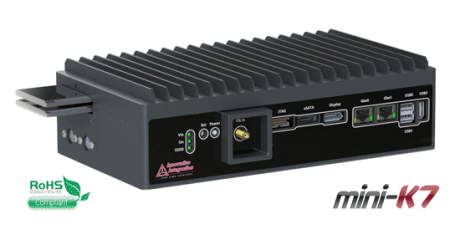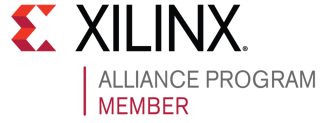Features
- FMC Embedded Computer – Standalone PC with FMC site.
- Low SWaP (Size Weight and Power) solution
- Combines an industry-standard COM Express CPU module with a single FMC I/O module in an extremely compact, stand alone design
- Programmable Kintex 7 325/410 and Spartan 6 FPGAs
- Small form factor: 4” H x 7” W x 10” D
- Conduction cooled design: Fins or cold-plate
- Stand-alone operation: Able to operate headless, booting from SSD
- Windows, Linux OS support. RTOS availability.
- Single VITA 57 FMC IO module site. Add anything from RF receivers to industrial control modules.
- Integrated timing and triggering support for IO includes GPS or IEEE1588 -disciplined clock
- Supports Innovative and third-party FMC modules for private data channels, triggering and timing features
- 4 USB ports, 1Gb Ethernet, SATA (up to 4), DisplayPort Touch Screen
- Up to 2 SSD (1.8 in)
- AC or DC operation
Chipset
- Analogue to Digital Converter(s) = N/A
- FPGA = Xilinx Kintex 7
- Digital to Analogue = N/A
Overview
The Mini-K7 is a user-customizable, FMC embedded computer instrument that includes a full Windows/Linux PC and supports a wide assortment of ultimate-performance FMC modules. The HPC FMC site can host the FMC-250, FMC-310, FMC-500, FMC-1000, FMC-Servo, FMC-SDF or the FMC-SFP+. With its modular I/O, scalable performance, and easy to use PC architecture, the Mini-K7 reduces time-to- market while providing the performance you need.
Distributed Data Acquisition – Put the Mini-K7 at the data source and reduce system errors and complexity. Optional GPS or IEEE1588-synchronized timing, triggering and sample control is available for remote I/O. Limitless expansion via multiple nodes. Up to 4 SSD for data logging.
Uniquely customizable – single FMC site for IO, user- programmable FPGA for IO interfaces, triggering and timing control, USB ports.
Optional screen and RF tray (hence some photos show it as a deeper box).
Remote or Local Operation – Continuous data streaming up to 3200 MB/s to SSD or Gb/s Ethernet. Optional, stand- alone, autonomous operation with GPS-synchronized sampling.
Rugged – SSD boot drive support in a compact, rugged footprint that is ready for embedded operation.
9-18V DC-Only Operation – Perfect for portable or automotive data loggers or waveform generators.
An alternative to consider is the ePC-K7 Kintex7 FMC Host which has dual FMC sites.
Dataflow
The board comes complete with working logic (Framework Logic) and software drivers (Malibu). Please see the data flow diagram.
The simplied data flow from Adc(s) to host application works as follows. Samples from the Adc(s) are clocked into the FPGA. The samples are packed where necessary for efficient use of the RAM chips. The RAM is used as a virtual FIFO to decouple the continuous stream of the Adc(s) from the block transfer nature of PCIe. The user application sets the packetsize. When a whole packet of data is available in the RAM, the PCIe DMA controller does a bus master transfer to the host memory. At configuration time the device drivers reserve physical memory for this purpose. When the transfer is complete, the DMA controller sends an interrupt to Malibu which then copies the packet from the busmaster area to virtual memory and then fires an event in the User application with a reference to the data.
On mini-K7 the Adc memory is 512MB.
The simplified data flow in the reverse direction for host to Dac(s) is similar. Onboard RAM is configured as a virtual FIFO between the PCIe and the Dac(s). When there is room in the RAM chips for a packet of samples, the PCIe DMA controller interrupts the host, which then signals the application to provide a packet of samples. The samples are copied from virtual memory to physical memory and then the PCIe DMA controller copies them into RAM. As data is flowed to the DAC(s) the RAM has more space for more packets and so the process is repeated.
On mini-K7 the Dac memory is 512MB.
Applications
- Embedded Instrumentation
- Remote, Autonomous IO
- Mobile Instrumentation
- Distributed Data Acquisition
Content on Youtube
These videos may be helpful in learning about using the FPGA on this board.





